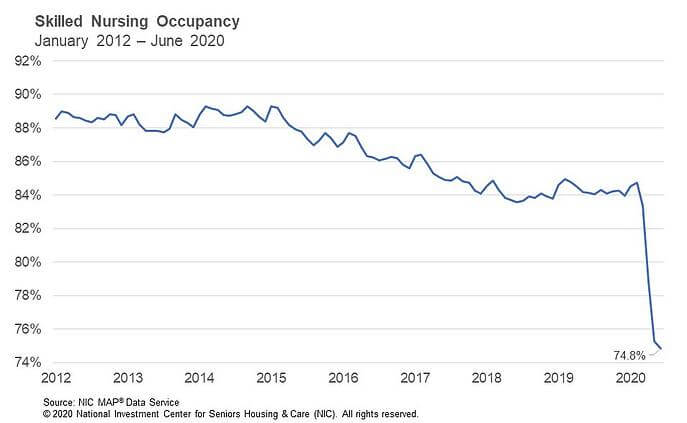Pace of Occupancy Decline Slows in Skilled Nursing
September 10, 2020
NIC MAP® Data Service released its first ever Skilled Nursing Monthly Report on August 31, 2020, which includes key monthly data points from January 2012 through June 2020.
Here are some key takeaways from the report:
1. With few signs of abating, the effects of the COVID-19 pandemic were still evident in the June skilled nursing data. The pace of the decline in occupancy slowed in June, but the rate hit a new record low of 74.8%. The 41 basis-point decline from May was the first month-over-month decline in occupancy less than 100 basis points since the start of the pandemic in March. This suggests that occupancies at skilled nursing properties may be starting to stabilize. However, significant uncertainty remains, especially as fall and winter approach. New challenges could arise with arrival of the flu season complicated by a possible resurgence of the COVID-19 virus. Since March, the occupancy rate has fallen 853 basis points from 83.4%. It is now down 990 basis points below February’s level. The year-over-year occupancy rate is down 930 basis points from June 2019 and down 871 basis points from the previous low set in June 2018, prior to the pandemic. Urban area occupancy has declined significantly more than rural areas, declining 970 basis points since March compared to 539 basis points in rural areas.

2. Managed Medicare patient day mix increased slightly from May, ending June at 5.5%. This was the first month-over-month increase, albeit small, since the pandemic started. However, it is still down 109 basis points since March and down 158 basis points since February when the managed Medicare patient day mix was 7.0%. In addition, managed Medicare revenue mix seems to be stabilizing. It was flat from May to June, ending June at 7.4%. However, it has declined 224 basis points since March and 303 basis points since February when it was 10.5%. The stabilization in June suggests that insurance enrollees may have started to resume elective surgeries as states began lifting the suspension of such procedures.
3. Medicare revenue mix declined slightly from May to June, ending at 20.4%. Although down, Medicare revenue mix has held up relatively well since the pandemic began in March, compared with other payors. It is only down 89 basis points since March compared to managed Medicare (down 224 basis points) and private (down 102 basis points). In addition, Medicare patient day mix has increased since March, from 11.2% to 11.9% in June. Although overall occupancy has declined dramatically during the pandemic creating significant pressure on skilled nursing operators, Medicare patient days likely did not decrease as much as it would have given that the Centers for Medicare and Medicaid Services (CMS) waived the 3-Day Rule, which required a 3-day inpatient hospital stay prior to a Medicare-covered skilled nursing stay.

4. Medicare (RPPD) was essentially flat from May to June, ending at $557.76. However, Medicare RPPD has increased 1.9% since March. It likely increased because of additional reimbursement for COVID-19-positive patients requiring isolation, in addition to the temporary suspension of the 2.0% sequestration cuts by CMS (effective May 1-December 31, 2020). The trend varies, however, in urban and rural areas. The increase in Medicare RPPD since March was only 0.2% in rural areas, but 2.4% in urban areas. This most likely reflects the increase in Medicare support for urban areas with higher levels of COVID-19 cases.
To get more trends from the latest data you can download the Skilled Nursing Monthly Report. There is no charge for this report.
The report provides aggregate data at the national level from a sampling of skilled nursing operators with multiple properties in the United States. NIC continues to grow its database of participating operators in order to provide data at localized levels in the future. Operators who are interested in participating can complete a participation form here. https://www.nic.org/skilled-nursing-data-initiative. NIC maintains strict confidentiality of all data it receives.
About Bill Kauffman
Senior Principal Bill Kauffman works with the research team in providing research and analysis in various areas including sales transactions and skilled nursing. He has lead roles in creating new and enhanced products and implementation of new processes. Prior to joining NIC he worked at Shelter Development in investing/acquiring, financing, and asset management for over $1 billion in assets. He also had key roles in the value creation and strategic planning and analysis for over 65 entities. He received his Bachelor of Business Administration in Finance from the College of Business and Economics at Radford University and his Master of Science in Finance from Loyola College in Maryland. He also holds the Chartered Financial Analyst Designation (CFA).
NIC MAP Vision gives operators, lenders, investors, developers, and owners unparalleled market data for the seniors housing and care sector.
